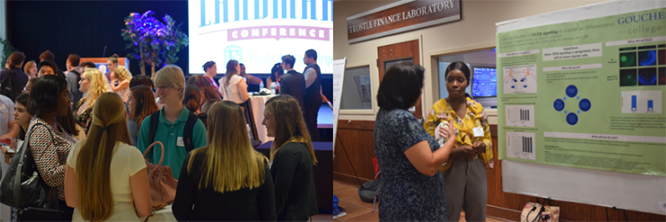Location
Presentations Session 2 - Hoover 214
Department
Biology
Start Date
11-7-2019 2:45 PM
End Date
11-7-2019 3:45 PM
Description
Cancer is most commonly thought of as the result of accumulation of cellular DNA mutations that inhibit tumor suppressor proteins or activate oncogenes. However a large body of evidence also shows that the wild type gene transcripts are alternatively spliced to create oncogenic protein isoforms or induce nonsense mediated decay of the RNA. To combat the cancerous cell growth, chemotherapy targets cellular activities such as DNA replication, spindle formation, receptor signalling, and metabolism. Knowing the protein profile of the tumor is relevant to finding an effective chemotherapeutic. For instance, cisplatin is used to treat a variety of cancers but has been shown to have reduced efficacy if the cell lacks the protein BIN1 or if it is alternatively spliced to the BIN1+12A isoform. Cisplatin forms platinum-DNA adducts that create single stranded breaks, and if not repaired can later become double stranded breaks following DNA replication. Unlike other tumor suppressors, BIN1 appears to induce cell death by increasing genomic instability. BIN1 is proposed to function by binding to the transcription factor E2F1, and preventing the activation of the DNA repair mechanism by ATM. This allows the breaks produced by cisplatin to disrupt cellular processes, such as DNA replication and transcription, and ultimately results in cell death (Folk 2019). While studying the mechanism of cellular transformation by the simian virus 40 (SV40) T-antigen oncoprotein, our lab has discovered a novel RNA isoform of BIN1. This transcript retains exon 11 yet deletes exons 12-18. Concomitant with characterizing the protein structure, this study is investigating the functional characteristic of this BIN1 isoform as it relates to cisplatin resistance. Human diploid fibroblasts immortalized with telomerase HDF (HDF(tert)) and HDF(tert) cells expressing the viral oncoprotein SV40 T antigen (HDF(tert)+T) will be used as the experimental model. A dose curve of cisplatin from 0-2ug/ml will be used to assess cellular sensitivity. Determining the function of this novel BIN1 isoform is essential to the chemotherapeutic success in cancer treatment.
Recommended Citation
Shangraw, Emma, "The effect of Cisplatin on Human Diploid Fibroblast Cells expressing SV40 T-Antigen" (2019). Landmark Conference Summer Research Symposium. 8.
https://jayscholar.etown.edu/landmark/2019/july11/8
Included in
The effect of Cisplatin on Human Diploid Fibroblast Cells expressing SV40 T-Antigen
Presentations Session 2 - Hoover 214
Cancer is most commonly thought of as the result of accumulation of cellular DNA mutations that inhibit tumor suppressor proteins or activate oncogenes. However a large body of evidence also shows that the wild type gene transcripts are alternatively spliced to create oncogenic protein isoforms or induce nonsense mediated decay of the RNA. To combat the cancerous cell growth, chemotherapy targets cellular activities such as DNA replication, spindle formation, receptor signalling, and metabolism. Knowing the protein profile of the tumor is relevant to finding an effective chemotherapeutic. For instance, cisplatin is used to treat a variety of cancers but has been shown to have reduced efficacy if the cell lacks the protein BIN1 or if it is alternatively spliced to the BIN1+12A isoform. Cisplatin forms platinum-DNA adducts that create single stranded breaks, and if not repaired can later become double stranded breaks following DNA replication. Unlike other tumor suppressors, BIN1 appears to induce cell death by increasing genomic instability. BIN1 is proposed to function by binding to the transcription factor E2F1, and preventing the activation of the DNA repair mechanism by ATM. This allows the breaks produced by cisplatin to disrupt cellular processes, such as DNA replication and transcription, and ultimately results in cell death (Folk 2019). While studying the mechanism of cellular transformation by the simian virus 40 (SV40) T-antigen oncoprotein, our lab has discovered a novel RNA isoform of BIN1. This transcript retains exon 11 yet deletes exons 12-18. Concomitant with characterizing the protein structure, this study is investigating the functional characteristic of this BIN1 isoform as it relates to cisplatin resistance. Human diploid fibroblasts immortalized with telomerase HDF (HDF(tert)) and HDF(tert) cells expressing the viral oncoprotein SV40 T antigen (HDF(tert)+T) will be used as the experimental model. A dose curve of cisplatin from 0-2ug/ml will be used to assess cellular sensitivity. Determining the function of this novel BIN1 isoform is essential to the chemotherapeutic success in cancer treatment.




Comments
Faculty mentor: Jane Cavender, Elizabethtown College.